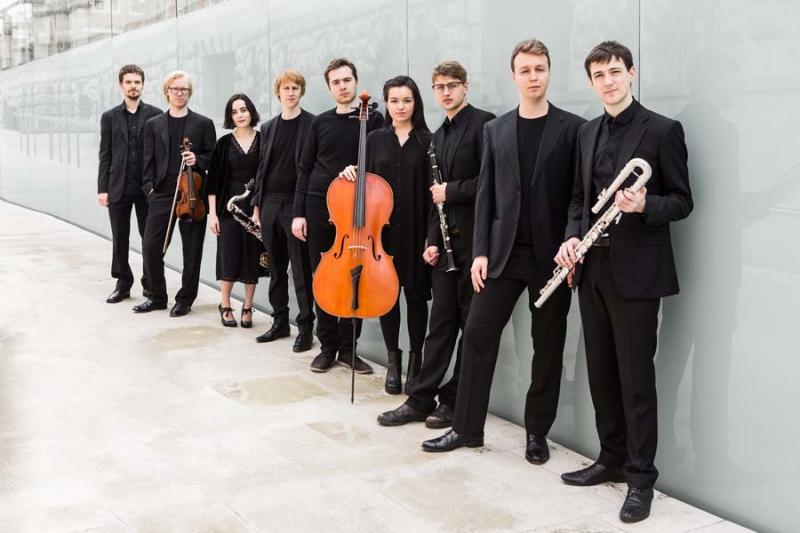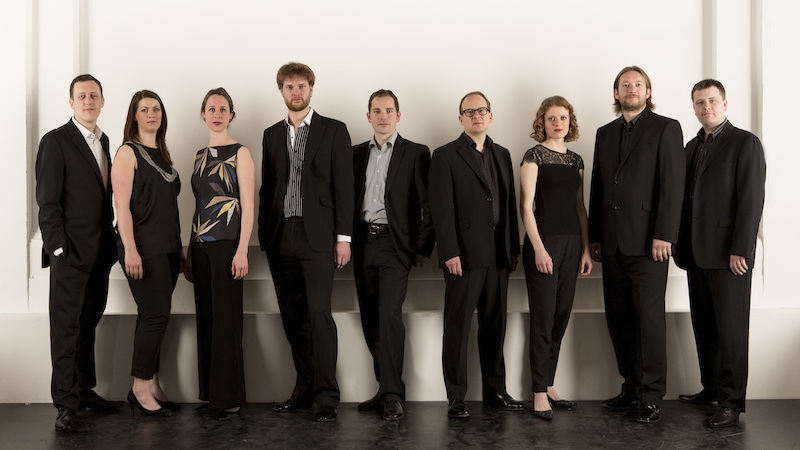Explore Ensemble, EXAUDI, St John's Smith Square review - making sense of Nono | reviews, news & interviews
Explore Ensemble, EXAUDI, St John's Smith Square review - making sense of Nono
Explore Ensemble, EXAUDI, St John's Smith Square review - making sense of Nono
Riveting 'Principal Sound' event delivers the luminous rewards of austerity modernism

This was an evening of silence and shadow, a chill, moonlit meditation, where each sound demanded forensic attention. Enter the world of Luigi Nono and his admirers.
Sunday’s concert at St John’s Smith Square completed the Principal Sound weekend, which focuses on music of the last half-century, this year Nono’s late works. Performed by crack contemporary vocal group EXAUDI (pictured below by Matthew Andrews) and the enterprising young Explore Ensemble, this imaginative sequence (by Principal Sound’s curator Sam Wigglesworth) revealed the relationship between the Italian's austere, fragmentary vision and those who followed, from Feldman, Cage and Kurtág to Rihm and Rebecca Saunders. It revolved around the twin pillars of Nono’s choral work Sarà Dolce Tacere and Wolfgang Rihm’s Quo me rapis.
These two starkly dramatic, fiendishly difficult eight-voice works made a penetrating impact. Nono’s was beautifully set up: first with Sciarrino’s delicate Lo Spazio Inverso, its barely-breathed tones on clarinet and strings periodically shattered by dazzling éclats on celesta. Then came Kurtág’s An…/A…, gentle oscillations of despair for solo baritone. In Sarà Dolce Tacere ("Silence shall be sweet"), Nono sets Cesare Pavese’s poetic evocation of a landscape of white light and rock, stripping all sense of syntax from the lines, each singer releasing precise peals into a void. Some collide, producing luminous harmony; often there's a sense of naked shards raining down. It wasn't until they came to rest "in flaming silence" that one fully appreciated the controlled power of the performance. Rihm’s Quo me rapis, written just as Nono was dying in 1990, has a clear kinship, with the addition of irrepressible ego. Two groups of singers faced each from the stage's extremities, conductor James Weeks isolated between them: here we have distance, gaping pauses, fragmentary utterances gradually intensifying to an old-fashioned climax. This is, as the text reads, "no slight or humble song", but a masterwork, realised with thrilling force.
Rihm’s Quo me rapis, written just as Nono was dying in 1990, has a clear kinship, with the addition of irrepressible ego. Two groups of singers faced each from the stage's extremities, conductor James Weeks isolated between them: here we have distance, gaping pauses, fragmentary utterances gradually intensifying to an old-fashioned climax. This is, as the text reads, "no slight or humble song", but a masterwork, realised with thrilling force.
Word-setting took a more conventional form in the premiere of Canadian Linda Catlin Smith’s Uncertain for 8 voices, Virginia Woolf’s pregnant, twilit phrases gently nudged into existence. Smith weaves a gossamer web of floating texture, deftly contrasted with the gleaming muscularity of Machaut virelai and John Cage’s commanding Five, realised by Explore’s performers with delicious poise.
Such juxtapositions were subtle, but crucial, as the players tip-toed through this frail, crystalline drift: in Feldman’s Voices and Cello, wondrously sung by members of EXAUDI with cellist Deni Teo, voices clashed, unified, twisted apart in a riveting mediation. What a relief, still, when violinist Oscar Perks broke the spell with Kurtág’s lusty little Carenza Jig. A bolt of colour in an icy world.
Colour was in short supply in Rebecca Saunders’ Molly’s Song 3 - Shades of Crimson: there was something rather comical about three pale young men fastidiously tinkering with guitar, viola and alto flute to summon Joyce’s paean to female orgasm. They seemed to be tugging at the frayed edges of an idea in Saunders' intricately-designed construction. Was Molly's savage "yes" in there somewhere, remote, abstracted? I sense Nono would have approved.
rating
Share this article
The future of Arts Journalism
You can stop theartsdesk.com closing!
We urgently need financing to survive. Our fundraising drive has thus far raised £49,000 but we need to reach £100,000 or we will be forced to close. Please contribute here: https://gofund.me/c3f6033d
And if you can forward this information to anyone who might assist, we’d be grateful.

Subscribe to theartsdesk.com
Thank you for continuing to read our work on theartsdesk.com. For unlimited access to every article in its entirety, including our archive of more than 15,000 pieces, we're asking for £5 per month or £40 per year. We feel it's a very good deal, and hope you do too.
To take a subscription now simply click here.
And if you're looking for that extra gift for a friend or family member, why not treat them to a theartsdesk.com gift subscription?
more Classical music
 Bizet in 150th anniversary year: rich and rare French offerings from Palazzetto Bru Zane
Specialists in French romantic music unveil a treasure trove both live and on disc
Bizet in 150th anniversary year: rich and rare French offerings from Palazzetto Bru Zane
Specialists in French romantic music unveil a treasure trove both live and on disc
 Scottish Chamber Orchestra, Ibragimova, Queen’s Hall, Edinburgh review - rarities, novelties and drumrolls
A pity the SCO didn't pick a better showcase for a shining guest artist
Scottish Chamber Orchestra, Ibragimova, Queen’s Hall, Edinburgh review - rarities, novelties and drumrolls
A pity the SCO didn't pick a better showcase for a shining guest artist
 Kilsby, Parkes, Sinfonia of London, Wilson, Barbican review - string things zing and sing in expert hands
British masterpieces for strings plus other-worldly tenor and horn - and a muscular rarity
Kilsby, Parkes, Sinfonia of London, Wilson, Barbican review - string things zing and sing in expert hands
British masterpieces for strings plus other-worldly tenor and horn - and a muscular rarity
 From Historical to Hip-Hop, Classically Black Music Festival, Kings Place review - a cluster of impressive stars for the future
From quasi-Mozartian elegance to the gritty humour of a kitchen inspection
From Historical to Hip-Hop, Classically Black Music Festival, Kings Place review - a cluster of impressive stars for the future
From quasi-Mozartian elegance to the gritty humour of a kitchen inspection
 Shibe, LSO, Adès, Barbican review - gaudy and glorious new music alongside serene Sibelius
Adès’s passion makes persuasive case for the music he loves, both new and old
Shibe, LSO, Adès, Barbican review - gaudy and glorious new music alongside serene Sibelius
Adès’s passion makes persuasive case for the music he loves, both new and old
 Anja Mittermüller, Richard Fu, Wigmore Hall review - a glorious hall debut
The Austrian mezzo shines - at the age of 22
Anja Mittermüller, Richard Fu, Wigmore Hall review - a glorious hall debut
The Austrian mezzo shines - at the age of 22
 First Person: clarinettist Oliver Pashley on the new horizons of The Hermes Experiment's latest album
Compositions by members of this unusual quartet feature for the first time
First Person: clarinettist Oliver Pashley on the new horizons of The Hermes Experiment's latest album
Compositions by members of this unusual quartet feature for the first time
 Gesualdo Passione, Les Arts Florissants, Amala Dior Company, Barbican review - inspired collaboration excavates the music's humanity
At times it was like watching an anarchic religious procession
Gesualdo Passione, Les Arts Florissants, Amala Dior Company, Barbican review - inspired collaboration excavates the music's humanity
At times it was like watching an anarchic religious procession
 Classical CDs: Camels, concrete and cabaret
An influential American composer's 90th birthday box, plus British piano concertos and a father-and-son duo
Classical CDs: Camels, concrete and cabaret
An influential American composer's 90th birthday box, plus British piano concertos and a father-and-son duo
 Cockerham, Manchester Camerata, Sheen, Martin Harris Centre, Manchester review - re-enacting the dawn of modernism
Two UK premieres added to three miniatures from a seminal event of January 1914
Cockerham, Manchester Camerata, Sheen, Martin Harris Centre, Manchester review - re-enacting the dawn of modernism
Two UK premieres added to three miniatures from a seminal event of January 1914
 Kempf, Brno Philharmonic, Davies, Bridgewater Hall, Manchester review - European tradition meets American jazz
Bouncing Czechs enjoy their Gershwin and Brubeck alongside Janáček and Dvořák
Kempf, Brno Philharmonic, Davies, Bridgewater Hall, Manchester review - European tradition meets American jazz
Bouncing Czechs enjoy their Gershwin and Brubeck alongside Janáček and Dvořák
 Solomon, OAE, Butt, QEH review - daft Biblical whitewashing with great choruses
Even a top soprano and mezzo can’t make this Handel paean wholly convincing
Solomon, OAE, Butt, QEH review - daft Biblical whitewashing with great choruses
Even a top soprano and mezzo can’t make this Handel paean wholly convincing

Add comment